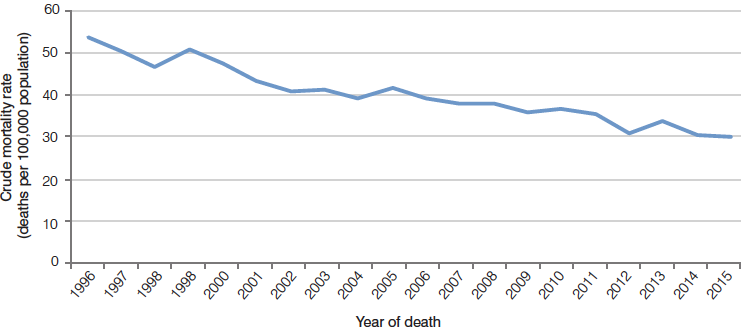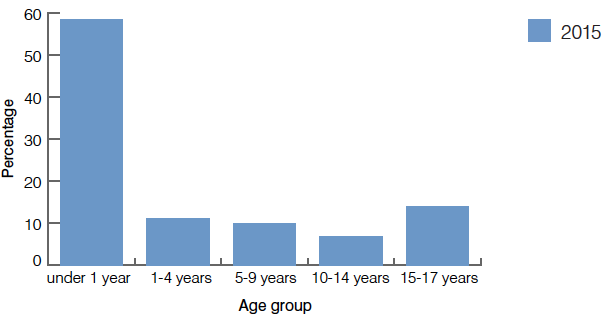
Deaths of children in NSW in 2015: key facts
In 2015, 504 children aged from birth to 17 years died in NSW in 2015; a mortality rate¹ of 29.61 deaths per 100,000 children. As shown in the figure below, this is the lowest annual rate recorded by the Child Death Review Team since the Team was established in 1996.
Figure 1: Deaths due to all causes: children 0-17 years, 1996-2015

Of the 504 children who died, 282 were male and 222 were female.
The majority of the children who died (294, 58%) were infants aged less than 12 months. Almost three quarters of these infants (208, 71%) died in the neonatal period; within 28 days of their birth.
Figure 2: Deaths due to all causes: children 0-17 years, by age group 2015

Causes of death
A cause of death was known for 458 of the 504 children.
Deaths due to natural causes
The majority of children (370; 81%²) died as a result of natural causes. Most of these children were infants, and together, conditions arising in the perinatal period and congenital and chromosomal conditions accounted for half of the deaths of children in 2015. There has been
a significant decline in the rate of death of children in NSW from natural causes over the past 15 years, and the mortality rate of 21.74 in 2015 was the lowest annual rate in 15 years. The decrease mostly reflects a decline in infant mortality.
| ICD Chapter | Number |
|---|---|
| Certain conditions arising in the perinatal period | 152 |
| Congenital malformations, deformations and chromosomal abnormalities | 85 |
| Neoplasms | 48 |
| Diseases of the nervous system | 37 |
| Endocrine, nutritional and metabolic disorders | 15 |
| Diseases of the respiratory system | 14 |
| Diseases of the blood, blood-forming organs and certain disorders of the immune system | 7 |
| Diseases of the circulatory system | 6 |
| Certain infectious and parasitic diseases | 3 |
| Diseases of the digestive system | 1 |
| Diseases of the genitourinary system | 1 |
| Mental and behavioural disorders | 1 |
| Total | 370 |
Deaths due to injury
Almost one in five children (88, 19%) died as a result
of injury. The deaths of 54 children resulted from unintentional injury. The deaths of 34 children were intentional; 26 were due to suicide, and eight children died in circumstances of abuse.
| Type of external cause | Number |
|---|---|
| Unintentional injury | |
| Transport | 33 |
| Drowning | 9 |
| Other unintentional (threats to breathing, poison, falls, fire) | 12 |
| Intentional injury | |
| Suicide | 26 |
| Assault | 8 |
| Total | 88 |
Leading causes of death by age group
Children aged 1-4 years
Conditions arising in the perinatal period (late pregnancy, birth and the first 28 days of life) have consistently been the leading cause of infant deaths over the last 15 years. This was also the case in 2015. Over half of all infant deaths between 2001 and 2015 were due to perinatal conditions (2,955 54%); most of these infants (93%) died in the first 28 days of life (neonatal period). The main perinatal conditions included maternal factors/pregnancy complications, disorders associated with prematurity, respiratory and cardiovascular disorders and infection.
Congenital and chromosomal conditions comprised the second leading cause of death of infants over the past 15 years and in 2015, with the main conditions including malformations of the circulatory, nervous and musculoskeletal systems. In the 15 years to 2015, sixty per cent of the infant deaths (885) from this cause occurred during the neonatal period.
Children aged 1-4 years
Congenital and chromosomal conditions comprised the overall leading cause of death in 2015 for children aged between 1 and 4 years. This differs from previous years, in which cancers and tumours have generally been the most frequent cause of death for this age group.
Drowning was the second leading cause of death for this age group over the past 15 years and in 2015. Over the 15 year period, drowning and transport fatalities have consistently been amongst the most frequent injury-related causes of death for this age group.
Children aged 5-14 years
Cancers and tumours have consistently been the overall leading cause death for children in the 5-9 and 10-14 year age groups. Over the 15 years to 2015, the main types of cancers and tumours causing the deaths of children in NSW were leukaemia and malignant tumours of the brain and central nervous system. This was also the case in 2015.
Transport fatalities and diseases of the nervous system were the equal second leading causes of death of children aged 5-9 years in 2015, and transport fatalities were the second leading cause of death of children in the 10-14 year age group. Over the past 15 years, transport fatalities have consistently been amongst the leading causes of death of children of this age.
Young people aged 15-17 years
Suicide was the leading cause of death for young people in 2015. In previous years, transport incidents have generally either been the leading or equal leading cause of death (with suicide) for young people.
Transport fatalities and cancers and tumours were the equal second leading causes of death of young people in 2015, and have consistently featured amongst the leading causes of death of young people over the past 15 years.
Trends in the deaths of children in NSW
While the overall decline in mortality rates for children aged less than 18 years has been significant and continual, it has not been uniform:
- the significant decline in the injury-related mortality rate over the 15 years to 2015 relates to males rather than females, and while the rate for males is still higher than for females, the gap has narrowed since 2001
- fifty-nine children (12%) who died in 2015 were identified as being of Aboriginal or Torres Strait Islander background; a mortality rate 2.3 times the rate for non-Aboriginal or Torres Strait Islander children (64.08 to 27.64). Injury-related causes were the overall leading cause of death of Aboriginal and Torres Strait Islander children in 2015, occurring at a rate almost five times higher than that of non-Indigenous children
- suicide was the leading cause of death for 15-17 year olds in 2015, and the suicide mortality rate for this age group in that year was the highest since 1997
- the mortality rate for nervous system diseases (which include conditions such as cerebral palsy and epilepsy) has risen since 2007
- the mortality rate for congenital and chromosomal conditions has not markedly changed over the past 15 years
- the mortality rate for cancers and tumours has declined only slightly since 2001. In 2015, cancers and tumours were the leading cause of death of children aged 5-14 years in NSW
- the infant mortality rate3 for Sudden Unexpected Death in Infancy (SUDI) has, overall, declined since 2001, however the rate has not changed significantly since 2008.
Since 1996, the CDRT has been responsible for reviewing and reporting to the NSW Parliament
on all deaths of children aged less than 18 years in NSW. The CDRT maintains a register of child deaths in NSW. The Team consists of experts in child health, child protection and related areas, and representatives of key government agencies. The Convenor of the Team is the NSW Ombudsman, and Ombudsman staff provide support and assistance to the Team.
Notes
- Crude mortality rate - deaths per 100,000 people under 18 years of age. For children aged less than 12 months, this report uses the Infant Mortality Rate, which is deaths of infants under 12 months per 1,000 live births.
- Based on a known cause of death (458 children)
- Infant mortality rate is deaths per 1,000 live births.
Contact us for more information
Level 24,
580 George Street
Sydney NSW 2000
Toll free (outside Sydney metro) 1800 451 524
Email cdrt@ombo.nsw.gov.au
National Relay System 133 677
Telephone Interpreter Service (TIS) 131 450
We can arrange an interpreter through TIS or you can contact TIS yourself before speaking to us.
© State of New South Wales, November 2016
This publication is released under a Creative Commons license CC BY 4.0.
Publication metadata
| ISBN | 978-1-925569-04-9 |
|---|---|
| Category | Fact sheets |
| Publication Date | 21 November 2016 |
